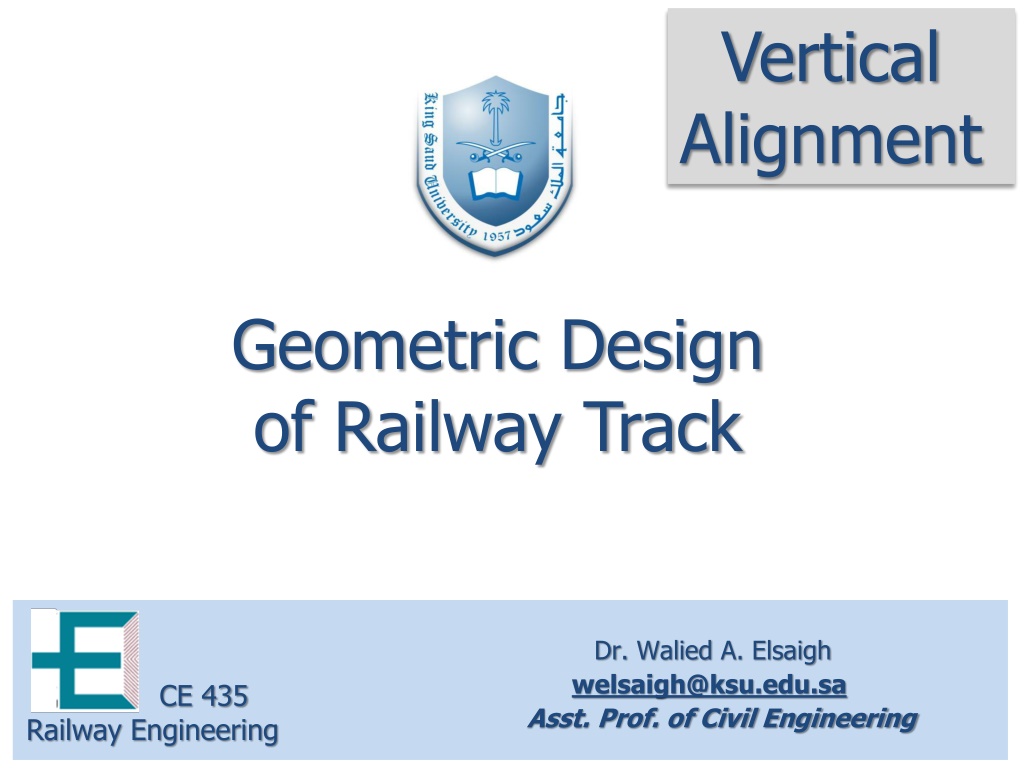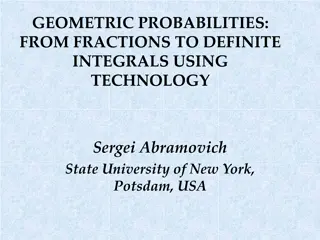Understanding Vertical Alignment in Railway Track Geometric Design by Dr. Walied A. Elsaigh
Explore the vertical alignment of railway tracks through Dr. Walied A. Elsaigh's insights on curve length formulas, types of crest and sag vertical curves, properties of typical vertical curves, and a detailed example with solutions for calculating elevations at various stations along the curve. Learn about traditional and modern formulas for designing vertical curves in railway engineering.
Download Presentation

Please find below an Image/Link to download the presentation.
The content on the website is provided AS IS for your information and personal use only. It may not be sold, licensed, or shared on other websites without obtaining consent from the author. Download presentation by click this link. If you encounter any issues during the download, it is possible that the publisher has removed the file from their server.
E N D
Presentation Transcript
Vertical Alignment Picture Geometric Design of Railway Track Dr. Walied A. Elsaigh welsaigh@ksu.edu.sa Asst. Prof. of Civil Engineering CE 435 Railway Engineering
Vertical Alignment Curve Length Railway vertical curves old formula: L = D / R D = algebraic difference of grade (ft. per 100-ft. station) R = rate of change per 100-ft. station 0.05 ft. per station for crest on main track 0.10 ft. per station for sag on main track Secondary line may be twice those for main line
Vertical Alignment Curve Length Old railway formula developed in 1880 s for hook and pin couplers in those days Present day couplers can accommodate shorter vertical curves New formula developed in recent years: L = 2.15 V2 D / A V = train speed in mph D = algebraic difference of grade in decimal A = vertical acceleration in ft./sec2 0.1 ft./ sec2for freight, 0.6 ft./ sec2for passenger or transit
EXAMPLE-1 A plus 3.0 percent grade intersects a minus 2.0 percent grade at station 3 + 20 and at an elevation of 320.40 ft. Given that a 180-ft length of curve is utilized, (1)Determine the station and elevation of the PVC and PVT. (2)Calculate elevations at every even 25-ft station (3)Compute the station and elevation of the high point of the curve
EXAMPLE (continued) EPVC = EPVI - (G1/100)(L/2) = 320.40 - 0.03(90) = 317.70 ft EPVT = EPVI - (G2/100)(L/2) = 320.40 - 0.02(90) = 318.60 ft Location of high point: High point Sta = PVC Sta + Xm= 230 + 108 = 338 Sta 3+ 38 Elevation of high point:
Calculations for point elevations at even 25-ft stations along the vertical curve Final Elevation x Elevation on Station y on Curve (feet) Initial Tangent (Elev on tan - y) 318.24 318.77 319.12 319.30 319.30 319.13 318.79 318.60 2 + 50 2 + 75 3 + 00 3 + 25 3 + 50 3 + 75 4 + 00 4 + 10 20 45 70 95 120 145 170 180 318.30 319.05 319.80 320.55 321.30 322.05 322.80 323.10 -0.06 -0.28 -0.68 -1.25 -2.00 -2.92 -4.01 -4.50























